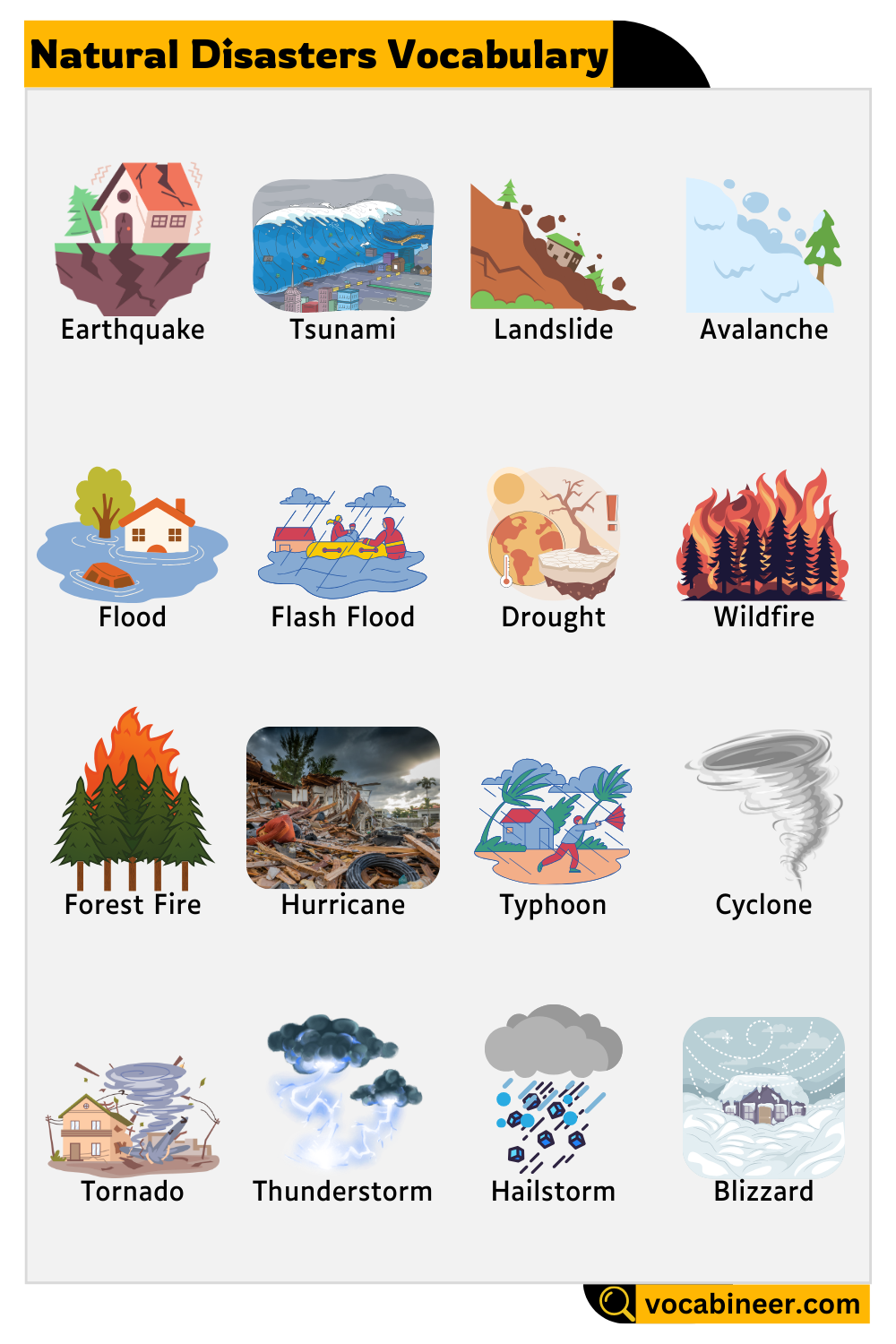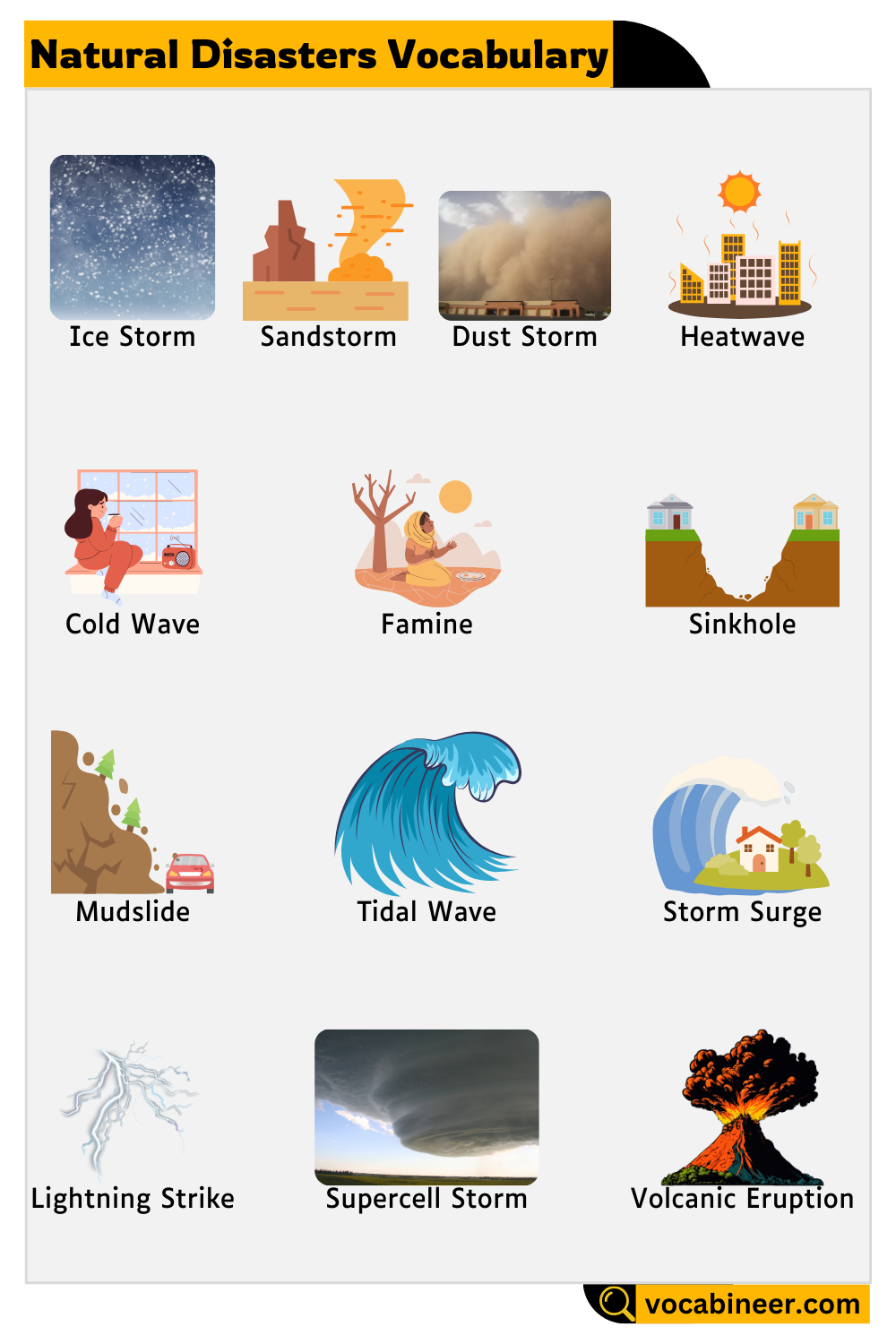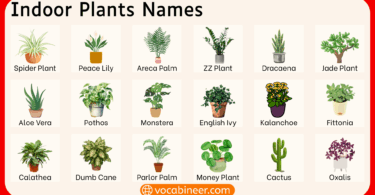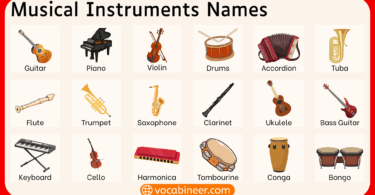Understanding natural disasters vocabulary is important for discussing safety, environment, and world events in English. These terms help describe sudden, dangerous events caused by nature. In this blog post, we will learn the English names of common natural disasters with pictures and clear categories.
To improve your vocabulary through visuals, visit our Picture Vocabulary section for more topics like this.
In This Page
Natural Disasters Vocabulary in English
Natural disasters can affect the land, sea, and air. They cause damage to the environment and human life. Learning their names helps you describe news, weather, and emergency situations clearly.
Geological Disasters
These disasters come from movements under the earth or changes in the ground.
Earthquake
A sudden shaking of the ground caused by movements under the earth’s surface.
Volcanic Eruption
An explosion of lava, ash, and gas from a volcano.
Landslide
A fast movement of rock and soil down a hill or mountain.
Mudslide
A flow of wet soil down a slope, often after rain.
Sinkhole
A deep hole that appears when the ground collapses suddenly.
Avalanche
A rapid fall of snow and ice down a mountain.
Hydrological Disasters
These are caused by water on the earth’s surface or under it.
Flood
When water overflows land that is usually dry.
Flash Flood
A sudden, strong flood that comes with heavy rain.
Tsunami
A series of large sea waves caused by an underwater earthquake.
Tidal Wave
A huge ocean wave that rises high and causes coastal damage.
Storm Surge
A rise in sea level during a storm that floods coastal areas.
Meteorological Disasters
These are caused by weather and changes in the atmosphere.
Hurricane
A large, rotating storm with strong winds and rain, formed over oceans.
Typhoon
A hurricane-like storm that happens in the western Pacific Ocean.
Cyclone
A storm with strong winds that spins around a center, usually in the Indian Ocean.
Tornado
A fast-spinning column of air that touches the ground, causing damage.
Thunderstorm
A storm with lightning, thunder, heavy rain, and sometimes hail.
Lightning Strike
A flash of electricity that hits the ground during a thunderstorm.
Hailstorm
A storm where ice balls (hail) fall from the sky.
Supercell Storm
A strong, rotating thunderstorm that can cause tornadoes and hail.
Blizzard
A snowstorm with strong wind and low visibility.
Ice Storm
A storm with freezing rain that coats surfaces in ice.
Sandstorm
Strong winds that blow sand particles in deserts.
Dust Storm
A windstorm that carries dry dust over a wide area.
Heatwave
A long period of very high temperatures.
Cold Wave
A sudden drop in temperature over a short time.
Polar Vortex
A large, cold air mass that brings freezing weather to lower regions.
Environmental Disasters
These result from both natural and human factors and affect food and health.
Drought
A long time with no rain, causing dry land and crop failure.
Wildfire
A fast, uncontrolled fire in grasslands or open areas.
Forest Fire
A wildfire that spreads through wooded areas, harming trees and animals.
Famine
A severe lack of food, often caused by drought or war.
Download Natural Disasters Infographic PDF
Download high-quality natural disasters vocabulary infographics in printable PDF format to boost your English learning with images.
FAQs
1. What are the most common types of natural disasters in English?
Common types include earthquake, flood, tornado, hurricane, drought, wildfire, and tsunami. These events are important vocabulary for news and safety.
2. What is the difference between a typhoon and a cyclone?
Typhoons occur in the western Pacific, while cyclones happen in the Indian Ocean. Both are intense storms with strong winds.
3. How can I learn disaster vocabulary easily?
Use pictures, categories, and real-world examples. Grouping by type helps with memory, and picture vocabulary makes meanings easier.
4. Why are some disasters called natural?
They are caused by nature, not human actions, such as earthquakes or hurricanes. This is why we call them natural disasters.
5. What vocabulary is used during emergencies?
Words like evacuation, rescue, damage, alert, emergency shelter, and disaster relief are common in emergency discussions.
6. Is tsunami the same as tidal wave?
No. Tsunamis are caused by underwater earthquakes, while tidal waves are large waves related to ocean tides.
7. What is a supercell storm?
It is a large rotating thunderstorm that can lead to tornadoes, hailstorms, and heavy rain. It is one of the most dangerous storm types.






